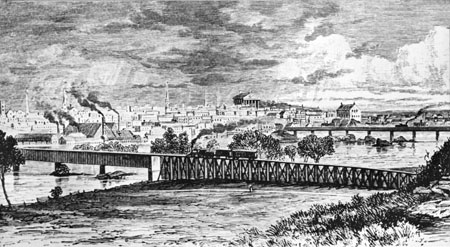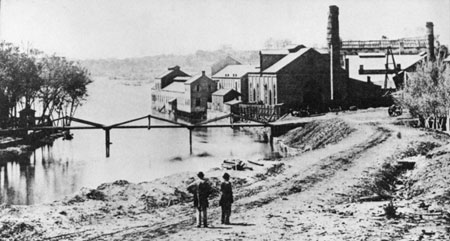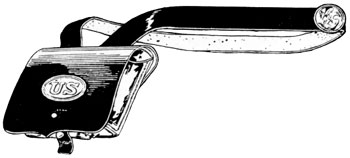|
RICHMOND National Battlefield Park |
 |

Richmond, 1858.
From a contemporary sketch.
THE AMERICAN CIVIL WAR was unique in many respects. One of the great turning points in American history, it was a national tragedy of international significance. Simultaneously, it was the last of the old wars and the first of the new. Although it began in a blaze of glamor, romance, and chivalry, it ended in the ashes of misery, destruction, and death. It was, as Walt Whitman said, "a strange, sad war."
Richmond National Battlefield Park preserves the scene's of some of the great battles that took place in the vicinity of the Confederate Capital. When we visit these now quiet, peaceful woods and fields, we feel an association with our past that is impossible to achieve with the written or spoken word. Here we are not reminded of the Blue or the Gray as such, only of the heroic struggle of men—men with two different beliefs and philosophies, welded together by the blood of battle, to give us our America of today.
Richmond
In session at Montgomery, Ala., in May 1861, the Confederate Congress voted to remove the Capital of the Confederate States to Richmond, Va. This decision, in effect, made Richmond a beleaguered city for 4 years. Essentially, the move was dictated by political and military considerations. The prestige of Virginia, richest and most populous State in the South, was considered necessary for the success of the Confederacy. For political reasons it was believed that the Capital should be near the border States and the heavy fighting expected there.
Second only to New Orleans, Richmond was the largest city in the Confederacy, having a population of about 38,000. It was also the center of iron manufacturing in the South. The Tredegar Iron Works, main source of cannon supply for the Southern armies influenced the choice of Richmond as the Confederate Capital and demanded its defense. During the course of the war, Tredegar made over 1,100 cannon, in addition to mines, torpedoes, propeller shafts, and other war machinery. It expanded to include rolling mills, forges, sawmills, and machine shops. The Richmond Laboratory made over 72 million cartridges, along with grenades, gun carriages, field artillery, and canteens, while the Richmond Armory had a capacity for manufacturing 5,000 small arms a month.

Tredegar Iron Works.
Courtesy, Library of Congress.
Thus Richmond became the political, military, and manufacturing center of the South, and the symbol of secession to the North.
Situated near the head of the navigable waters of the James River, and within 110 miles of the National Capital at Washington, Richmond was the key to the military planning of both sides. For 4 years the city remained the primary military objective of the Union armies in the east. As one southern newspaper stated: "To lose Richmond is to lose Virginia, and to lose Virginia is to lose the key to the Southern Confederacy."


|

|
|
Last Modified: Mon, Mar 4 2002 10:00:00 pm PDT |


